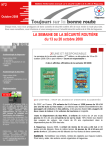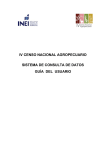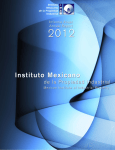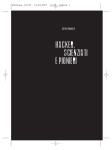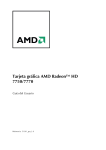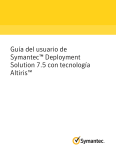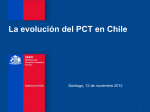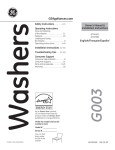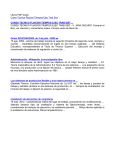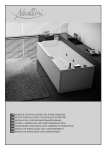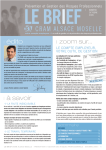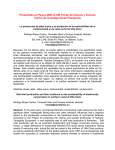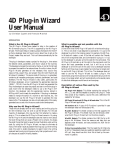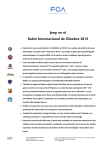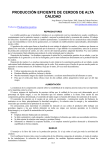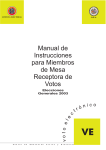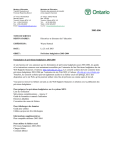Download Indicadores Mundiales de Propiedad Intelectual 2011
Transcript
INSTITUTO NACIONAL DE PROPIEDAD INDUSTRIAL _ INAPI 02 REPORTE ANUAL 2012 Presentación PRESENTATION Hace exactamente un año, con la publicación del primer reporte INAPI, esperábamos, primero, celebrar la adolescencia de nuestra institución y luego crear una tradición: publicar anualmente este reporte, que acompañado de estadísticas, diera cuenta en breves páginas del trabajo realizado en INAPI y del estado de la propiedad industrial a nivel nacional. One year ago when we published our first INAPI report, we expected to first celebrate the adolescence of our institution and then to create a tradition by releasing this report annually. So, in a few pages and the use of statistics, the purpose is to inform about the work that has been done by INAPI and the advances of industrial property nationally. Con ya tres años de vida, podemos decir que INAPI ha alcanzado la mayoría de edad durante el Gobierno del Presidente Sebastián Piñera. Una nueva Ley de Propiedad Industrial será ingresada prontamente al Congreso. Hemos digitalizado, mejorado y modernizado el Instituto. Luego de un enorme esfuerzo en conjunto con la Organización Mundial de la Propiedad Intelectual estamos operando sobre una plataforma informática completamente nueva, más estable y dinámica que funciona a la par de nuevos servicios de tramitación en línea. Lanzamos recientemente la Plataforma del Conocimiento o INAPI Proyecta, con el objeto de hacer aún más difusión y transferencia tecnológica y finalmente, como reflejo de la renovación completa del Instituto, INAPI cuenta hoy con un nuevo edificio donde nuestros usuarios podrán acceder a los distintos servicios de manera más cómoda y expedita. Three years have passed since we started operating, and we can now say that during the Presidency of Mr. Sebastián Piñera INAPI has come of age. A new industrial property law will be submitted soon to the Congress. We have digitized, enhanced and modernized the Institute. After an enormous effort in conjunction with the World Intellectual Property Organization (WIPO) we are now operating on a completely new, more stable and dynamic IT platform that works alongside the new online processing services. We recently launched our own Knowledge Platform or INAPI Projects in order to enhance the work done with regards to dissemination of knowledge and technology transfer. Finally, as a reflection of the complete renovation of the Institute, INAPI now has a new building where our users can access all different services we provide in a more convenient and expeditious way. Este año será sin duda un tiempo de cosecha y estamos muy orgullosos de poner todos estos avances a disposición de nuestros usuarios. Sin embargo, sabemos que aún queda mucho por hacer. INAPI tiene las capacidades para seguir participando tanto a nivel regional como mundial, y colaborar de esta manera con la consolidación de Chile como polo regional de innovación. This year will certainly be a one of harvest and our users will be able to take benefit from all these efforts. However we believe that much remains to be done both in Chile and internationally. INAPI has the capabilities to continue to participate both regionally and globally and thus assist with the consolidation of Chile as a regional hub of innovation. Ha sido grande el esfuerzo y el compromiso de todos quienes trabajamos en INAPI y es gracias a ello que hoy podemos afirmar que contamos con una institución madura, seria y en contacto con los usuarios. Esto nos permite enfrentar este año del emprendimiento y prepararnos para el 2013, año de la innovación, con la confianza necesaria para cumplir con las metas fijadas. Esperamos que este reporte sea un buen reflejo de este compromiso. Both the effort and the commitment of all of those who work at INAPI has been strong and thanks to this we can now confidently say that we have a mature, serious and well connected institution with all our users. The progress made so far allows us to face this year of entrepreneurship and to prepare for 2013, the year of innovation, with the confidence to meet the targets. We hope this report is a good reflection of this commitment. Maximiliano Santa Cruz Scantlebury Director Nacional Instituto Nacional de Propiedad Industrial National Director of INAPI Este segundo informe anual da cuenta de los logros y proyectos del año 2011 así como de la evolución del registro de los derechos de propiedad industrial. This second annual report reflects the achievements and projects of 2011 as well as the evolution of the registration of industrial property rights during the year. 03 INSTITUTO NACIONAL DE PROPIEDAD INDUSTRIAL _ INAPI 04 REPORTE ANUAL 2012 03 Presentación 05 Índice 06 Institucionalidad 08 Hacia un mejor sistema de propiedad intelectual 09 Miradas 10 Acercando la propiedad industrial a la sociedad 12 INAPI en el Siglo XXI 13 Publicaciones 14 INAPI al servicio de creadores y emprendedores 16 Servicio / Canales de atención 17 Tendencias 18 Patentes 20 Diseños Industriales y Modelos de Utilidad 21 Marcas (Solicitud y Clasificaciones) 23 Indicaciones Geográficas y Denominaciones de Origen 24 Chile en el Informe "Indicadores Mundiales de Propiedad Industrial 2011" 27 Ranking 05 INSTITUTO NACIONAL DE PROPIEDAD INDUSTRIAL _ INAPI Institucionalidad OUR INSTITUTION En enero de 2009 inició sus actividades el Instituto Nacional de Propiedad Industrial (INAPI), sucesor legal del Departamento de Propiedad Industrial del Ministerio de Economía (DPI). In January 2009 the National Industrial Property Institute (INAPI), successor of the Department of Industrial Property of Ministry of Economy began its activities. INAPI es el organismo encargado de la administración y atención de los servicios de la propiedad industrial en Chile. Le corresponde, asimismo, promover la protección que brinda la propiedad industrial y difundir el acervo tecnológico y la información de que dispone. INAPI is the agency responsible for the management of industrial property rights and related services in Chile. INAPI is also responsible for promoting the protection afforded by industrial property rights as well as for disseminating the technological heritage and the information available. Debido a que el desarrollo e innovación de un país van de la mano de la creación y la inventiva, el nacimiento de INAPI es un factor de gran relevancia para nuestro país. El Instituto contribuye a la estrategia de innovación y emprendimiento impulsada por el Gobierno de Chile, generando sistemas eficientes para el uso y protección de los derechos de propiedad industrial, promoviendo además la competencia y la transferencia de conocimiento a la comunidad. VISIÓN INAPI se constituirá en una institución líder a nivel mundial en el registro, gestión y promoción de la propiedad industrial, sobre la base de procesos y tecnología óptimos, elevada capacidad de servicio, alta confiabilidad e imparcialidad, y focalizada en el continuo mejoramiento de su desempeño, para aportar al emprendimiento e innovación en Chile. MISIÓN La misión principal de INAPI es contribuir al desarrollo económico nacional estimulando el emprendimiento, la innovación y la creatividad mediante la protección de la propiedad industrial y la gestión del conocimiento. Para ello, debe procurar procesos que aseguren la eficacia y calidad, así como la accesibilidad y certidumbre de la información. OBJETIVOS ESTRATÉGICOS Nuestra meta es convertir al Instituto en una oficina de primer nivel. Para ello hemos definido una serie de objetivos estratégicos destinados a organizar y orientar sus distintas líneas de acción. En materia de registro, el servicio busca gestionar oportuna y adecuadamente la protección de los derechos de propiedad industrial, enfocados siempre en la calidad de éstos, para contribuir desde este ámbito al emprendimiento e innovación nacional. Lo mismo puede decirse respecto de su función como tribunal especial de primera instancia que resuelve los juicios de oposición y de nulidad sobre los derechos de propiedad industrial que administra. Como encargados de difundir el acervo tecnológico del país, hemos establecido como objetivo primordial facilitar el acceso, en especial al dominio público, a través de la gestión del conocimiento disponible. En este mismo sentido, nos hemos abocado a crear capacidades en materia de propiedad industrial, fortaleciendo la capacidad de estudio, promoción y asesoramiento en estos ámbitos. En materia internacional, nuestros esfuerzos se centran en posicionar adecuadamente a Chile en las redes de cooperación y coordinación nacionales e internacionales de propiedad industrial. Finalmente, a nivel nacional, nuestro objetivo es generar e implementar propuestas legislativas y de políticas públicas, que contribuyan a fortalecer, modernizar y perfeccionar el sistema de propiedad intelectual. 06 Because the development and innovation of a country go hand in hand with creativity and inventiveness, the birth of INAPI is a major factor for our country. The Institute contributes to the innovation and entrepreneurship strategy driven by the Government of Chile generating efficient systems for the use and protection of industrial property rights, by promoting also competition and transfer of knowledge to the community. VISION INAPI aims at becoming a world leader in the registration, management and promotion of industrial property, on the basis of optimal processes and technology, outstanding service, high reliability and impartiality. INAPI focuses on the continuous improvement of its performance, to contribute to entrepreneurship and innovation in Chile. MISSION The primary mission of INAPI is to contribute to the development of the economy by stimulating entrepreneurship, innovation and creativity through the protection of industrial property and management of knowledge. To achieve this objective, it should strive to ensure effective processes and quality as well as accessibility and certainty of information. STRATEGIC OBJECTIVES Our goal is to transform the Institute into a first class office. To this purpose we have defined a set of strategic objectives aimed at organizing and directing our different lines of action. With regards to registration, INAPI seeks to manage timely and adequately the protection of industrial property rights, always focusing on their quality, in order to contribute to national entrepreneurship and innovation. The same applies to its role as a specialized court of first instance to resolve opposition and nullity proceedings of the industrial property rights we administer. As responsible for disseminating the country's technological heritage, we have established the primary objective to facilitate access, particularly to the information on the public domain, through the management of available knowledge. Pursuing this same objective, we are committed to creating capacities, strengthening the skills related to the study, promotion and advice in all areas related to industrial property. Internationally, our focus is on positioning Chile in the cooperation and coordination networks of industrial property. Finally, at the national level we aim to generate and implement proposals for legislation and public policy that help strengthen, modernize and improve the intellectual property system. REPORTE ANUAL 2012 PERSONAS Y ESTRUCTURAS A diciembre de 2011 la dotación de INAPI alcanzó a los 171 funcionarios, 57% de ellos mujeres y 43% hombres, con una edad promedio de 40 años. Del total de funcionarios, un 51% corresponde al estamento profesional. En comparación con los promedios a nivel de Gobierno es posible destacar que INAPI cuenta con una proporción entre hombres y mujeres similar a la general y con una presencia de profesionales superior a la del poder Ejecutivo en general, donde este porcentaje alcanzó solo el 39% durante el año 2010. Esta situación responde principalmente a la naturaleza de los servicios que presta INAPI. El nivel de preparación es esencial para la calidad de los derechos que se conceden. En este mismo sentido, los esfuerzos en capacitación son una prioridad para el Instituto, habiéndose capacitado a 129 funcionarios durante el año 2011. El personal de INAPI se distribuye en siete áreas: Subdirección de Marcas; Subdirección de Patentes; Subdirección Jurídica; División Administrativa; Subdirección de Transferencia de Conocimiento; División de Desarrollo y la Dirección Nacional, que a su vez integra a las áreas de Comunicaciones, Estudios y Políticas Públicas, Departamento Legislativo, Departamento Internacional, Auditoría Interna, y Planificación y Control de Gestión. PEOPLE AND STRUCTURES Until December 2011 INAPI staff reached 171 employees, 57% of which are women and 43% men, with an average age of 40 years. Of the total staff, 51% corresponds to professionals. Compared to the government averages INAPI has a ratio between men and women similar to the general and a higher rate of professionals compared with the 39% general average. This situation is mainly due to the nature of the services provided by INAPI. The level of preparation is essential for the quality of the rights granted. In this sense, efforts in training are a priority. During 2011, 129 of our employees received some sort of training. INAPI staff is divided into seven areas: Trademarks, Patents, a Legal Department, a Division for the Management and Transfer of Knowledge, a Development Division and the National Directorate composed by the areas of Communications, Studies and Public Policy, Legislation, International affairs, Internal Audit and Management Planning and Control. DISTRIBUCIÓN DEL PERSONAL POR UNIDADES DISTRIBUCIÓN DEL PERSONAL - INAPI DISTRIBUTION OF STAFF BY UNITS DISTRIBUTION OF STAFF - INAPI 5% Subdirección de Transferencia del Conocimiento 5% Directivo 8 directivos 41 años promedio 51% Profesional 88 funcionarios 40 años promedio 31% Administrativo 53 funcionarios 41 años promedio 12% Técnico 20 funcionarios 41 años promedio 1% Auxiliar 2 funcionarios 32 años promedio DISTRIBUTION OF STAFF - CENTRAL GOVERNMENT 4% Directivo 8.323 directivos 39% Profesional 79.148 funcionarios 19% Administrativo 39.068 funcionarios 28% Técnico 55.953 funcionario 13% División de Desarrollo 4% Subdirección Jurídica 25% Subdirección de Patentes DISTRIBUCIÓN PERSONAL - ADMINISTRACIÓN PÚBLICA (AÑO 2010) 26% Subdirección de Marcas 11% Dirección Nacional 17% División de Administración y Finanzas 1O% Auxiliar 20.667 funcionarios FUENTE: Estadísticas de Recursos Humanos del Sector Público, 2010 - 2011, Dirección de Presupuestos, Gobierno de Chile. La educación continua es clave para el buen desempeño de INAPI. Durante el 2011 se capacitó al 75% de los funcionarios. For INAPI, continuing education is key to good performance. During 2011, 75% of our staff received training. 07 INSTITUTO NACIONAL DE PROPIEDAD INDUSTRIAL _ INAPI Hacia un mejor sistema de propiedad intelectual TOWARDS A BETTER INTELLECTUAL PROPERTY SYSTEM La creación de INAPI fue el primer gran paso hacia la constitución de un Sistema de Propiedad Intelectual en Chile capaz de cumplir con las exigencias de nuestro nivel de desarrollo. El emprendimiento y la innovación son claves para el mejoramiento de la calidad de vida de todos y la propiedad intelectual como herramienta para incentivar la creación no puede quedarse atrás, sino por el contrario, debe ser un catalizador de dichos avances. A la fecha los esfuerzos estuvieron destinados a instalar INAPI. Para ello, las mejoras a nivel informático han sido esenciales, así como también la creación dentro de la estructura institucional de departamentos y unidades destinadas a dar cumplimiento a las nuevas responsabilidades con que se dotó al instituto. Habiendo enfrentado y cumplido este desafío, hoy es posible continuar mirando hacia el futuro. Así, luego de un largo trabajo de estudio y con la colaboración y comentarios de nuestros usuarios, hoy contamos con un proyecto de Ley que busca reemplazar la Ley de Propiedad Industrial de 1991 para hacerla más eficiente y mejor adaptada a las necesidades de innovadores y emprendedores. Junto con una nueva ley, y para hacer frente al aumento en el uso del sistema como consecuencia de las actividades de difusión y posicionamiento, se convirtió en una necesidad contar con instalaciones adaptadas a los servicios que ofrece INAPI. Las nuevas instalaciones ofrecen espacios especialmente diseñados para la atención de nuestros usuarios, facilitando la realización de trámites y mejorando la calidad del servicio que se entrega. Finalmente, la propiedad industrial en su calidad de herramienta debe estar en estrecha relación con las distintas áreas de la economía tanto a nivel nacional como internacional. Para ello, durante 2011 se firmaron distintos acuerdos de colaboración, entre ellos, con la Fiscalía Nacional Económica, la Universidad Católica de la Santísima Concepción y las oficinas de propiedad industrial de Paraguay y México. En este mismo contexto, se destinaron importantes esfuerzos para el éxito del proyecto PROSUR, iniciativa que conecta a los examinadores de patentes de nueve países de la región, entregando así mejores herramientas para el análisis de patentes, fomentando la calidad y la eficiencia. The creation of INAPI was the first milestone towards the establishment of an intellectual property system that meets the needs imposed by our level of development. Entrepreneurship and innovation are critical to improving the quality of life for all. Intellectual property, as a tool to encourage creation cannot be left behind, but instead, should be a catalyst for such advances. To this date, all efforts were focused in the proper installation of INAPI, in this context improvements on information technology, as well as the creation within the institutional structure of departments and units to fulfill the new responsibilities of the institute have been essential. Having faced and met this challenge, it is now possible to continue to look into the future. Thus, after a long process of study and with the cooperation and feedback from all our users, we now have a bill that seeks to replace the Industrial property act of 1991 to make it more efficient and better adapted to the needs of our innovators and entrepreneurs. Along with a new law and to deal with the increased use of the system as a result of outreach activities carried forward, it became a must for us to have facilities specially adapted to the services offered INAPI. The new facilities are INAPI’s response to all the needs that have been identified and will have areas specifically designed for the attention of our users to improve the quality of the service provided. Finally, because industrial property is a tool and not an end in itself, it has to be in close relation to both the different areas of the economy at the national level and also with the international framework. To this end, during 2011 we signed several cooperation agreements, including the ones agreed with the, Fiscalía Nacional Económica (Chile’s competition authority), the Universidad Católica de la Santísima Concepción and the industrial property offices of Paraguay and Mexico and most recently the People’s Republic of China. Also, significant efforts were destined for the success of PROSUR, an initiative that connects patent examiners from nine countries in South America, thus providing better tools for patent analysis to promote both quality and efficiency. Una política de propiedad intelectual balanceada requiere estar en constante coordinación con las distintas áreas de interés para el país y colaborar para el cumplimiento de los objetivos que cada Ministerio defina. A balanced intellectual property policy needs to be in constant coordination with the various areas of interest to the country and work to fulfill the objectives set by each ministry. 08 REPORTE ANUAL 2012 Miradas La transformación del antiguo Departamento de Propiedad Industrial (DPI) en el nuevo INAPI, vino acompañada de la definición de nuevas funciones relacionadas con la promoción de la herramienta de la propiedad industrial, la transferencia del conocimiento y la proposición de políticas públicas en la materia. Estas nuevas atribuciones se ven reflejadas en una serie de proyectos e iniciativas que van mucho más allá del registro de los derechos. Se trata de actividades que permiten dar coherencia al sistema y lograr que la propiedad industrial cumpla no solo su fin de protección a innovadores y emprendedores, sino que también, de fomento al desarrollo del país y al mejoramiento del bienestar general. The transformation of the former Department of Industrial Property (DPI) in the new INAPI, was accompanied by the definition of new functions related to the promotion of industrial property, knowledge transfer and advice on issues related to public policy. These new responsibilities translate into a number of projects and initiatives that go far beyond the record of rights. These activities aim at giving coherence to the system and ensure that industrial property provides not only protection to innovators and entrepreneurs, but also, encourages the development of the country and improves the general welfare. 09 INSTITUTO NACIONAL DE PROPIEDAD INDUSTRIAL _ INAPI Acercando la propiedad industrial a la sociedad AN INDUSTRIAL PROPERTY SYSTEM CLOSER TO SOCIETY Entendiendo la necesidad de crear un ecosistema que fomente el uso y respeto de la propiedad intelectual, durante 2011 se realizaron una serie de actividades de difusión destinadas no sólo al público especializado, sino que a la sociedad en general. Entre estos proyectos, cabe destacar la exposición sobre la Historia de la Propiedad Industrial en Chile. Basada en el libro homónimo lanzado por la institución en noviembre de 2010, la exposición debutó en la Biblioteca Nacional de Chile, donde fue exhibida gratuitamente entre el 17 de junio y el 29 de julio, pudiendo ser apreciada diariamente por más de mil personas. Posteriormente, esta exitosa muestra fue exhibida en el Centro Cultural Gabriela Mistral (GAM), en el marco de Forum Raíz Diseño 2011. Finalmente, fue presentada durante noviembre en el Museo de Artes Visuales (MAVI), en el marco del Simposio Internacional de Protección del Diseño organizado por INAPI y la Organización Mundial de Propiedad Intelectual (OMPI). Junto a ello, INAPI desarrolló el Ciclo de Cine sobre Inventos e inventores, actividad gratuita y abierta a la comunidad que durante un mes recorrió la vida de inventores y emprendedores que marcaron la historia. 10 Understanding the need to create an ecosystem that encourages the use and respect of intellectual property, in 2011 we launched a series of outreach activities for both experts and non experts in the field. These projects included an exhibition on the history of industrial property in Chile that took place during the month of August in the National Library, which was also presented at the Centro Cultural Gabriela Mistral, reaching more than 30,000 visitors. The exhibition was complemented by the showing of films about different inventors. Continuing the work on historical research, we created a virtual museum with five rooms dedicated to relevant trademarks and patents as well as a collection of interesting patents and those that have changed our history in some way or another. REPORTE ANUAL 2012 Continuando con el trabajo de investigación histórica, hemos creado un Museo Virtual de INAPI, con cinco salas que incluyen galerías de marcas y patentes históricas, así como también una colección de patentes novedosas. Con el objeto de poner en evidencia la vinculación de la Propiedad Industrial con otras áreas de interés nacional, se realizaron además distintas charlas sobre temas tan diversos como los distintos tipos de marcas, la relación entre Propiedad Industrial y competencia y la importancia y sistema de protección de las variedades vegetales. A fin de fortalecer la política de innovación y emprendimiento a través del posicionamiento de la Propiedad Industrial, entre agosto de 2011 y enero de 2012 se realizaron ocho talleres con los principales actores regionales en las ciudades de Arica, Iquique, Antofagasta, La Serena, Temuco, Valdivia, Puerto Montt y Punta Arenas. Estos talleres se suman a las actividades de capacitación que INAPI realiza de forma habitual a lo largo del país y a través de videoconferencias por medio de Red Universitaria Nacional (REUNA). Por último, se realizaron capacitaciones sobre materias específicas, para usuarios avanzados y otros organismos públicos que nos permite avanzar en la construcción de un mejor y más completo sistema. In order to highlight the connection of Industrial Property with other areas of national interest we organized several talks on topics as diverse as the different types of trademarks, the relationship between industrial property and competition and the importance and functioning of the system for the protection of plant varieties. To collaborate in strengthening the innovation and entrepreneurship strategy by creating capacities on industrial property between August 2011 and January 2012 we held eight workshops with key players in different Chilean cities, such as Arica, Iquique, Antofagasta, La Serena, Temuco, Valdivia, Puerto Montt and Punta Arenas. During these activities we addressed topics such as industrial property and its benefits and some other more specialized issues for advanced users and other organisms within the government which allow us to move forward in building a better and more complete system. Para facilitar el uso del registro por parte del usuario, INAPI TV entrega, a través de youtube, tutoriales sobre cómo registrar los distintos derechos de propiedad industrial. Radio INAPI por su parte, transmite música chilena de todos los géneros e incluye programas de difusión de la P.I To facilitate the registration process, INAPI TV will show via youtube tutorials on how to register different industrial property rights. Radio INAPI in turn, transmits Chilean music of all genres and broadcasts outreach programs on IP. 11 INSTITUTO NACIONAL DE PROPIEDAD INDUSTRIAL _ INAPI Inapi en el Siglo XXI INAPI IN THE 21ST CENTURY Uno de los principales requisitos para que un sistema de propiedad intelectual funcione es que la realización de trámites sea amigable y sencilla, por lo que la atención de usuarios es un factor fundamental. En este contexto, no solo capacitamos constantemente a los funcionarios encargados de esta labor, sino que además, buscamos agilizar trámites a través del uso de tecnologías disponibles, y evitar, dentro de lo posible, que nuestros usuarios tengan que acercarse a las oficinas de INAPI para la realización de trámites. Hemos lanzado el nuevo portal web de nuestra Institución, que gracias a su renovada estructura y contenidos, facilitará el acceso a la más completa información sobre propiedad industrial. Para agilizar las consultas relativas al estado de tramitación de las solicitudes, contamos hoy con un servicio telefónico, que entrega esta información de manera automática, permitiendo descongestionar las consultas personales y por internet. Por otra parte, la exitosa implementación del sistema informático IPAS (Industrial Property Automation System) favorecerá la realización de trámites en línea, lo que sumado a la instalación de un sistema de solicitudes, pagos y emisión de títulos y certificados a través de internet, permitirá hacer trámites sin necesidad de concurrir a nuestras oficinas, beneficiando especialmente a quienes viven en regiones, además de habilitar la realización de dichos trámites fuera del horario de oficina. Finalmente, hemos avanzado enormemente en el trabajo de digitalización del total de nuestros expedientes de marcas y patentes, anhelada meta comprometida en el marco de la Agenda de Impulso Competitivo del Gobierno del Presidente Sebastián Piñera. Digitalización y el reemplazo tecnológico, incluido IPAS, son las herramientas que nos permiten hoy pensar en proyectos tan innovadores como teletrabajo al interior de INAPI. One of the main requirements for a well functioning intellectual property system is that all procedural aspects are friendly and simple. In this context, user services are essential. To this purpose our professionals are not only trained constantly, but we also promote the use of all available technologies to streamline procedures and to avoid, where possible, that our users have to approach INAPI offices. Among the many initiatives in this area we have launched a new Web portal for our institution that thanks to its reinforced structure and content will provide access to the most varied and complete information on industrial property. To facilitate the consultation process relating to status of requests, we now have a telephone service that provides this information automatically, avoiding congestion on the Internet and personal consultations. Moreover, the successful implementation of our new computer system IPAS (Industrial Property Automation System) installed with the collaboration of WIPO, will allow for online processing of applications which, added to the installation of a system of applications, payment and issuance of certificates through the internet will permit accessing to a full range of services without having to visit our offices. This will be especially useful for those living outside of Santiago or that have difficulties coming to INAPI outside of regular office hours. Finally, we have made tremendous progress in digitization of all our records for trademarks and patents, a project inserted in the “Agenda de Impulso Competitivo” (competitive impulse) carried forward by the Government of President Sebastián Piñera. Digitization and the complete replacement of our technological infrastructure, including IPAS, are the tools that allow us today to start thinking of innovative projects such as telecommuting in INAPI. Gracias al aprovechamiento de las herramientas tecnológicas, hoy es posible pensar en proyectos como la emisión de títulos y certificados electrónicos, la completa tramitación en línea y el teletrabajo, iniciativas de vanguardia que favorecerán tanto el servicio como la calidad de vida de nuestros usuarios y funcionarios. Thanks to the use of technological tools it is now possible to think of projects such as telecommuting and complete online processing, cutting-edge initiatives that will undoubtedly have a positive impact both in service and the quality of life our users and staff. 12 REPORTE ANUAL 2012 Publicaciones PUBLICATIONS Para potenciar los esfuerzos realizados en difusión, durante 2011 se lanzaron una serie de publicaciones destinadas a facilitar el acceso a la información tanto de la ley como de INAPI en general. Así, en enero se lanzó la “Compilación Normativa de Propiedad Intelectual”, publicación que reúne en un solo libro de más de 700 páginas por cerca de 50 normas nacionales e internacionales relevantes en materia de P.I. con referencias cruzadas entre las distintas normas. También en enero se publicó el libro "Marcas comerciales, Manual de Procedimiento de INAPI" (Directrices de Marcas), obra pionera en Latinoamérica que busca facilitar el procedimiento de registro de marcas y hacer públicos los criterios que INAPI utiliza, contribuyendo a elevar los estándares de calidad de los procedimientos marcarios y a brindar mayor seguridad jurídica a los solicitantes. En abril, y con motivo de la celebración del Día Mundial de la Propiedad Intelectual, se publicó por primera vez el “Reporte INAPI 2011” que da cuenta del uso de la PI y funcionamiento de INAPI durante los últimos 10 años. Asimismo, se continuó con la publicación periódica de boletines de tecnologías de dominio público, en febrero se presentó el último boletín de la serie “A reconstruir Chile con la ayuda de la propiedad industrial” y se comenzó a editar, en enero de ese año, un newsletter mensual con temas de actualidad en P.I. To enhance the efforts done in outreach, in 2011 we launched a series of publications to facilitate access to information about both the law and INAPI in general. In January 2011 we released the first compilation on intellectual property laws that puts together in one book of over 700 pages, nearly 50 national laws and international agreements relevant to IP with cross-references between them. Also in January we launched the book "Marcas comerciales, Manual de Procedimiento de INAPI " (Trademark Guidelines), pioneer work in Latin America that seeks to facilitate the registration procedure of trademarks and make public the criteria used by INAPI, helping to raise quality standards and efficiency of the procedures and providing greater legal certainty to all applicants. In April, for the celebration of World Intellectual Property Day we published the first "Reporte INAPI" which accounts for the use of IP and INAPI’s operations for the past 10 years. We also continued with the publication of bulletins of technological inventions in the public domain, released in February the last number of the series “A reconstruir Chile con la ayuda de la propiedad industrial” (Reconstructing Chile with the help of IP) and began publishing in January a monthly newsletter with current issues on IP. En materia de patentes, INAPI publicó la “Guía del Usuario PCT-INAPI como Oficina Receptora”, la que fue distribuida en casi todos los países latinoamericanos. Finalmente, y con el objeto de mejorar el acceso a la información relativa a observancia, se publicó un micro sitio web en el que participan representantes del sector privado, del Ministerio del Interior, Policía de Investigaciones y Servicio Nacional de Aduanas, entre otros. Protege tu idea (http://www.inapi.cl/protegetuidea/) ha sido visitado más de 400.000 veces en el último año. With regards to patents, INAPI published the "Guía del Usuario PCTINAPI como Oficina Receptora" (PCT User’s Guide-INAPI as a receiving office) that was distributed in almost all Latin American countries. Finally, in order to improve access to information relating to enforcement, we released a micro site with the collaboration of private sector representatives as well as the Ministry of Interior, the Police and the National Customs Service among others. “Protege tu idea” (http://www.inapi.cl/protegetuidea/) has been visited over 400,000 times in the past year. A objeto de facilitar el procedimiento de patentamiento a través del sistema Tratado de Cooperación en Materia de Patentes (PCT), durante 2011 se distribuyó la Guía de Usuario PCT, publicación conjunta de INAPI y OMPI enviada a 10 países de la región. During 2011, and in order to facilitate the process of patenting through the Patent cooperation treaty, the " Guía del Usuario PCT-INAPI como Oficina Receptora", a joint publication of WIPO and INAPI was launched and sent to 10 countries in the region. 13 INSTITUTO NACIONAL DE PROPIEDAD INDUSTRIAL _ INAPI Inapi al servicio de creadores y emprendedores INAPI AT THE SERVICE OF ENTREPRENEURS La creación puede tomar diversas formas y la propiedad intelectual nos da herramientas para gestionarla de manera de aprovechar al máximo sus beneficios. Como una forma de apoyar los distintos ámbitos en que la creación tiene lugar, a partir del 10 de abril de 2012 está disponible INAPI Proyecta, una plataforma digital financiada en conjunto por la Unión Europea y el Gobierno de Chile, que permite a emprendedores, investigadores, inventores y a la comunidad en general, identificar oportunidades para emprender, innovar y crear mediante el uso y la gestión de la propiedad industrial. Para ello, el sistema ofrece un conjunto de herramientas y servicios, como cursos e-learning, informes de búsqueda tecnológica y una caja de herramientas en materia de propiedad industrial, que apoya los procesos de innovación y emprendimiento; servicios de acceso gratuito vía web, que permiten llegar a todos los rincones del país, teniendo la posibilidad de acceder a información sobre residentes en las principales fuentes de información mundiales sobre un universo de 40 millones de documentos. Para los primeros cursos de elearning a través de la plataforma, recibimos 460 postulaciones demostrándose con ello el interés que existe en la materia y la utilidad que tendrá el proyecto en el futuro. Creation can take many forms and intellectual property gives us tools to manage it to maximize its benefits. As a way to support the various areas where creation takes place, we recently launched INAPI Projects, a digital platform jointly funded by the European Union and the Government of Chile, which allows both entrepreneurs, researchers and inventors and, in general the national community, to identify opportunities to initiate new investments, to innovate and to create through the use and management of industrial property. The system offers a set of tools and services such as e-learning courses, technological research reports and a toolbox of industrial property, which supports the processes of innovation and entrepreneurship. Access is via Internet, making it possible to reach all corners of the country and the world. INAPI Projects provides the possibility to access data in the main sources of global information in a universe of 40 million documents. For the first e-learning courses through the platform we received over 460 nominations demonstrating thereby the interest that exists in the area and the utility it will have in the future. Paralelamente, y cumpliendo con el deseo de potenciar tipos de propiedad intelectual menos conocidos o utilizados, se ha trabajado intensamente con el Ministerio de Economía en la identificación y promoción de nuevas Denominaciones de Origen (DO), Indicaciones Geográficas (IG), Marcas de Certificación y Marcas Colectivas. El objetivo es promover la asociatividad y competitividad de productores locales y artesanos facilitando el posicionamiento de productos con gran identificación local, tanto a nivel nacional como internacional. Parallel to INAPI Projects, and complying with the desire to strengthen the use of intellectual property, specially of those IP rights that are less used, we have worked extensively with the Ministry of Economy in the identification and promotion of new appellations of origin, geographical indications, certification marks and collective marks. This project named “Programa de Protección del Producto Chileno” promotes associativity and competitiveness of local producers and artisans by providing tools to position products with strong local identity, both nationally and internationally. INAPI sólo cuenta con oficinas en Santiago, por lo que las actividades que se realizan en regiones son de vital importancia para lograr acercar a la propiedad industrial a todos los rincones del país. INAPI only has offices in Santiago, which is why organizing activities in the different regions of the country is essential to bring intellectual property closer to all corners of the country. 14 REPORTE ANUAL 2012 15 INSTITUTO NACIONAL DE PROPIEDAD INDUSTRIAL _ INAPI Servicio SERVICE Durante el 2011, y como consecuencia natural del enorme esfuerzo realizado en materia de difusión, las consultas de usuarios aumentaron en un 11%. Si bien la mayoría de ellas siguen siendo presenciales, el uso de servicios en internet ha ido en constante aumento. En ese sentido, el mejoramiento tecnológico es crucial para entregar un mejor servicio. Además de la constante capacitación de los funcionarios del área, durante 2012 se implementarán sistemas de consulta automática vía telefónica, tutoriales a través de YouTube y programas en Radio Inventiva, la radio de INAPI, con información sobre el funcionamiento de la institución y del contenido de los distintos formularios para la presentación de solicitudes. During the year 2011, and as a natural consequence of the enormous efforts put into dissemination, user queries increased by 11%. While most of them are still done in person, the use of Internet tools has been steadily increasing. In this context, technological improvements are crucial to deliver a better service. In addition to the ongoing training of our staff in the area during 2012 an automatic telephone consultation system will be implemented in addition to tutorials on YouTube and programs on Radio Inventiva, INAPI’ s on-line radio, with information on the operation of INAPI and content of the different forms for filing. CANALES DE ATENCIÓN INAPI recibe consultas presenciales en los módulos de Atención General y Especializada de Marcas y Patentes, ubicados en nuestras oficinas de Atención de Público. Adicionalmente, se reciben consultas a través del link http://electron.inapi.cl/oirs/virtual.php o del correo electrónico [email protected]. SERVICE CHANNELS INAPI provides orientation to all users through the different specialized staff member in our offices both in trademarks and patents. Additionally, you can send your queries through a specially created link on our website (http://electron.inapi.cl/oirs/virtual.php) or you can send them via email to [email protected]. CONSULTA PATENTES CONSULTA DE MARCAS PATENTS CONSULTATIONS TRADEMARK CONSULTATIONS 82% 18% Consultas Presenciales Consultas Internet 63% Consultas Presenciales 37% Consultas Internet 62% Consultas Presenciales 38% Consultas Internet 58% Consultas Presenciales 42% Consultas Internet NOTA: Información estadística del Departamento de Orientación al Solicitante de Marcas, dependiente de la Subdirección de Marcas, creado el año 2009, cuya función es prestar asesoría especializada en signos distintivos. En nuestras nuevas dependencias de Atención de Público se contará con pantallas que actualizarán los estados diarios para un mejor acceso de los usuarios a esta información. In our new premises, screens will display information on the state of certain applications to achieve an easier access to information by our users. 16 REPORTE ANUAL 2012 Tendencias 17 INSTITUTO NACIONAL DE PROPIEDAD INDUSTRIAL _ INAPI Patentes PATENTS Las patentes de invención entregan protección a las creaciones que cumplan con los requisitos de novedad, nivel inventivo y aplicación industrial. Como contrapartida al derecho exclusivo de 20 años, el invento es divulgado, aumentando así la información tecnológica disponible y consecuentemente el bienestar general. En materia de estadísticas, d urante 2011, vimos un incremento de un 260% en la presentación de nuevas solicitudes. La magnitud del crecimiento es consecuencia directa del ingreso de Chile al Tratado de Cooperación en materia de Patentes (PCT). Previo a la entrada en vigencia del PCT, la cantidad de solicitudes nuevas cada año bordeaba las 3.800. Si bien se estimó en un primer momento que Chile volvería a los niveles pre PCT en un lapso de a lo menos cuatro años, la tasa de recuperación ha sido considerablemente mayor. Si se analiza el tipo de presentaciones de solicitudes nuevas, queda en evidencia el elevado uso del sistema PCT durante 2011. Si bien durante el año 2010 solo un 20% de las solicitudes ingresaban a través del nuevo sistema, en 2011 más del 80% lo hizo. Esta situación puede explicarse por el elevado número de solicitantes no residentes en el país y por la fuerte difusión realizada. Durante 2011 la Guía de Usuario PCT elaborada por INAPI en colaboración con OMPI fue repartida a la mayor parte de los países de la región, además de continuar con la capacitación a nivel interno para lograr el mejor uso posible del nuevo sistema. Patents give protection to inventions that meet the requirements of novelty, inventive step and industrial application. In return for the 20 years exclusive rights, the invention is disclosed, thus increasing the technological information available and consequently increasing the general welfare. With regards to statistical information, during 2011 we saw an increase of 260% in the submission of new applications. This magnitude of growth is a direct consequence of Chile's accession to the Patent Cooperation Treaty (PCT). Prior to the entry into force of the PCT, the number of new applications each year lined the 3,800. While it was initially estimated that Chile would recover pre-PCT numbers over a period of at least four years, the recovery rate has been considerably higher. An assessment of the type of new filings provides evidence of the high use of the PCT in 2011. In 2010 only 20% of requests were entered through the new system compared to 2011 where over 80% were filed through the PCT. The increase in usage of the PCT can potentially be attributed to the high number of non-resident applicants as well as the strong outreach activities that took place in 2010 and 2011. Among the outreach activities, a special acknowledgement needs to me made for the Guía de Usuario PCT that was distributed to almost all the countries of the region and part of all the in house trainings designed to achieve the best performance possible within INAPI. CANTIDAD DE SOLICITUDES DE PATENTES DE INVENCIÓN PATENT APPLICATIONS 1.074 2.792 2010 2011 INCREMENTO DE SOLICITUDES PCT EN 2011 PCT INCREASE PARIS 81% PCT 19% 2010 18 PARIS 21% PCT 79% 2011 Gracias a los esfuerzos en preparación y creación de capacidades para hacer frente a los desafíos impuestos por el ingreso a Chile al PCT, la tasa de recuperación superó todas las expectativas. Se espera que durante 2012 el uso del sistema de patentes vuelva a los niveles pre PCT. Thanks to the efforts in preparation and capacity building to address the challenges posed by the entry of Chile into the PCT system, the recovery rate exceeded all expectations. It is foreseeable that during 2012 the amount of new applications comes back to the normal rate. REPORTE ANUAL 2012 Al igual que en muchos países en desarrollo, el sistema de patentes es utilizado mayormente por no residentes. En el caso de Chile, las presentaciones de residentes han alcanzado históricamente un promedio cercano al 10%. Durante 2010 esta proporción aumentó, existiendo cerca de un 30% de presentaciones nacionales. Esta anormalidad se debe mayormente a los efectos que tuvo la entrada en vigor del PCT. Éste, durante los primeros años retrasa la entrada de solicitudes de no residentes pero no así las de nacionales que mantienen su conducta habitual en cuanto al registro. Por último, el alto patentamiento por extranjeros es reflejo de la confianza en la economía nacional y su dinamismo. En este sentido, la recuperación de las proporciones normales entre residentes y no residentes demuestra una vez más el buen funcionamiento del sistema en su globalidad. INAPI, al igual que la gran mayoría de las oficinas de patentes del mundo, debe hacer frente a los desafíos impuestos por un sistema cada vez más utilizado y donde las invenciones son cada día más complejas. Estas características pueden traducirse en aumentos en los tiempos de tramitación y del backlog o atraso en la tramitación de patentes. En un esfuerzo constante, INAPI ha trabajado por aumentar la eficiencia y educar a los usuarios para lograr un uso del sistema que permita tramitar en tiempos razonables las solicitudes que se presenten. Asimismo, la colaboración, especialmente a nivel internacional, puede ser una herramienta eficaz para evitar duplicaciones innecesarias y lograr acortar tiempos y mejorar la calidad. Con este objetivo, Chile, en conjunto con ocho países de la región, han puesto en marcha el proyecto PROSUR, con el objeto que examinadores de las distintas oficinas compartan el trabajo realizado y aumenten la información disponible al momento de analizar una patente. PATENTES DE INVENCIÓN PRESENTADAS Residentes No Residentes PATENT APPLICATIONS BY APPLICANT ORIGIN As in most developing countries, the use of the patent system is largely by non-residents. In Chile, the applications by residents have historically achieved an average of about 10%. In 2010 this increased, to almost 30%. An abnormality that is largely due to the effects of entry into force of the PCT. In the early years of implementation the PCT created delays in the submissions of non-resident applications. An issue not reflected in the resident user base that has exhibited a more consistent usage. In this regard the recovery of normal proportions between residents and nonresidents once again demonstrates the correct functioning of the system as a whole. INAPI, like the vast majority of patent offices in the world, must face the challenges of a system under increasing usage and where inventions are becoming more complex. The growing usage demands and complexity of submissions can lead to an increase in processing times and the accumulation of backlogs. In an ongoing effort, INAPI has worked to increase efficiency and educate users to be able to process applications in a timely manner. Furthermore, collaboration, especially at the international level can be an effective tool to avoid unnecessary duplication and achieve shorter times and overall improve quality. To this end, Chile, along with eight countries in the region has launched the project PROSUR allowing today examiners of the various offices to share their work and increase the information available when analyzing a patent. Del total de presentaciones de patentes del año 2011, el 80% corresponde a solicitudes PCT en que INAPI ha sido elegida como oficina designada. Durante 2011, INAPI resolvió 971 más solicitudes de las que ingresaron al sistema, reduciendo así el stock de solitudes en trámite. 70% 88% 30% 2010 2011 SOLICITUDES PATENTES PRESENTADAS / TERMINADAS Terminadas Presentadas APPLICATIONS PRESENTED / APPLICATIONS SOLVED 5.000 3.767 3.814 4.000 2.796 3.000 12% El elevado uso del sistema de patentes por solicitantes no residentes da cuenta de la confianza de empresas extranjeras en la economía del país, además de la buena percepción que existe de INAPI a nivel internacional. Of all patent submissions in 2011, 80% were through the PCT system with INAPI as the designated office. During 2011, INAPI resolved more 971 applications than the number of applications received, reducing therefore the pending backlog. 2.000 1.074 1.000 0 2010 2011 The high use of the patent system by non-resident applicants reflects a confidence of foreign companies in the country's economy as well as a strong international perception of INAPI. 19 INSTITUTO NACIONAL DE PROPIEDAD INDUSTRIAL _ INAPI Diseños Industriales y Modelos de Utilidad INDUSTRIAL DESIGNS AND UTILITY MODELS Más allá de las patentes, la propiedad intelectual entrega herramientas para la protección de invenciones menores y mejoras incrementales, comunes en emprendimientos de menor envergadura. Los diseños industriales y modelos de utilidad son un claro ejemplo de ello. De acuerdo a lo que ha sido la tendencia en los últimos años, el número de solicitudes es baja pero con un alto porcentaje de solicitudes nacionales. Con el fin de promover un mejor uso de estos derechos, INAPI ha llevado adelante una serie de iniciativas destinadas a difundir su uso y evaluar posibles mejoras. Durante 2011, realizamos el Simposio Internacional de Protección del Diseño Industrial y participamos activamente del Foro Raíz Diseño, uno de los eventos más importantes de esta disciplina. Asimismo, hemos promovido la comunicación entre la oficina, abogados y diseñadores mediante reuniones destinadas a incorporar en nuestro proyecto de ley un sistema amigable, expedito y eficaz de protección de modelos y diseño industrial. El resultado quedó plasmado en el proyecto que reemplaza la Ley de Propiedad Industrial, creando un sistema moderno y flexible que combina registro y depósito en el beneficio de nuestros emprendedores. DISEÑOS INDUSTRIALES SOLICITADOS Residentes No Residentes INDUSTRIAL DESIGN APPLICATIONS 8% 92% 12% 2011 MODELOS DE UTILIDAD SOLICITADOS UTILITY MODEL APPLICATIONS 20% 80 Residentes No Residentes 24% 76 % 2010 20 The results of the increased engagement are reflected in the bill that seeks to replace the industrial property law, creating a modern and flexible system that combines registration and deposit in the benefit of our entrepreneurs. 88% 2010 % 2011 Beyond patents, IP provides tools for the protection of minor inventions, incremental innovations, and smaller ventures. Industrial designs and utility models are specific examples of the protection IP provides. According to what has been the trend in recent years, the number of requests for these industrial property rights is low but with a high percentage of national applications. In order to promote a better promote of these rights, INAPI has conducted a series of initiatives to expand its use and evaluate possible improvements to their regulation. During 2011, we hosted the International Symposium on Industrial Design Protection and we actively participate in Foro Raiz Diseño, one of the most important events of this discipline. We have also promoted communication between the office, lawyers and designers through meetings aimed at identifying possible improvements to incorporate into the new law in order to achieve a more friendly, prompt and efficient protection of utility models and industrial designs. Para agilizar y promover el uso de los diseños y modelos de utilidad, en el proyecto de reforma a la Ley que INAPI promueve, los inventores y emprendedores podrán optar por un sistema de registro o depósito dependiendo de las necesidades de cada caso. To facilitate and promote the use of designs and utility models, the proposed amendments to the law that promotes INAPI, inventors and entrepreneurs may opt for a system of registration or deposit depending on the needs of each case. REPORTE ANUAL 2012 Marcas TRADEMARKS Las marcas, junto con las Indicaciones Geográficas y Denominaciones de Origen, son un eficaz elemento ordenador de los mercados, colaborando en la diferenciación de productos y servicios y evitando la confusión en el público consumidor. Trademarks, along with geographical indications and appellations of origin are an effective element to organize markets, contributing to the differentiation of products and services and avoid confusion in the consuming public. En 2011 se solicitaron 5.000 marcas más que en 2010. Con un aumento tanto en las solicitudes nuevas como en las renovaciones. Este dato es especialmente relevante si consideramos que en Sudamérica, junto con Uruguay, Chile el único país que actualmente permite solicitudes multiclase. Respecto de las marcas nuevas, el incremento fue de 12% con respecto al año anterior, mientras que las renovaciones crecieron en 20% en relación a 2010. In 2011 more than 5,000 new trademarks were applied for in comparison to 2010, an increase of 12% over the previous year while renewals increased by 20% compared to 2010. This number is particularly remarkable considering that in South America, besides Uruguay, Chile is the only country that currently allows multiclass applications. La evidencia empírica muestra una importante relación entre las solicitudes de marcas nuevas y el desempeño económico. El registro de una nueva marca es un fiel indicador de crecimiento en las empresas y la creación de nuevos emprendimientos. Así, al comparar el Indicador Mensual de Actividad Económica (IMACEC) y el registro de solicitudes de marcas nuevas se puede constatar que el comportamiento de ambas series es similar para el periodo comprendido entre marzo de 2008 y diciembre de 2011. De esta comparación es posible concluir que un aumento en la actividad económica necesariamente va asociado a un aumento de las solicitudes de marcas nuevas que se presentan en INAPI. Empirical evidence shows a significant relationship between the number new trademark applications and economic performance. Registration of new trademarks is a reliable indicator of growth in business and the creation of new ventures. Thus, when comparing the monthly economic activity index (IMACEC) and registration of new trademark applications the corresponding similarities are overwhelmingly apparent during March 2008 and December 2011. From this comparison it can be concluded that an increase in economic activity will be associated with an increase of new trademark applications that are presented in INAPI. TOTAL MARCAS TIPO MARCA SOLICITADA AÑO 2011 TRADEMARK APPLICATIONS 2011 TRADEMARK APPLICATIONS BY TYPE 3% Marca Figurativa 32.422 Marca Nueva 35.880 12.682 Renovación Marca Nueva 2010 15.209 Renovación 60% Marca Denominativa 2011 SOLICITUDES DE MARCA E IMACEC Al observar el tipo de marcas solicitadas durante el año 2011, observamos que el 60% corresponden a marcas denominativas. Este porcentaje se mantiene en comparación al 2010 al igual que el nivel de marcas mixtas solicitadas, las cuales correspondieron a un 35% del total de marcas. Solicitudes de Marca Imacec (Var % sobre año previo, promedio trimestre móvil) 36% 12% 27% 9% 18% 6% 9% 3% 0% 0% -9% -3% -18% -6% -27% -9% -36% -12% Mar May Jul Sep Nov Ene Mar May Jul Sep Nov Ene Mar May Jul Sep Nov Ene Mar May Jul Sep Nov 2009 FUENTE: Banco Central de Chile, Ministerio de Economía 2010 35% Marca Mixta 2011 IMACEC Solicitudes de Marcas 2% Marca Propaganda TRADEMARK APPLICATIONS AND THE IMACEC Looking at the different types of trademarks applied for during 2011, we observed that 60% are word marks. This percentage is practically the same compared to 2010. The same can be concluded with regards to mixed trademarks where the percentage reached 35% of the total applications. Gracias a los esfuerzos realizados en el marco del Programa de Promoción del Producto Chileno, hoy contamos con la primera Indicación Geográfica para un producto del mar (la langosta de Juan Fernández) y la primera Marca de Certificación del país (el Sello ProPyme, otorgado durante los primeros meses de 2012). Thanks to the efforts made in the framework of Programa de Promoción de Producto Chileno, we now have the first geographical indication for a sea product (Lobster Juan Fernandez) and the first certification trademark of the country for the Sello Propyme that was granted during the first months of 2012. 21 INSTITUTO NACIONAL DE PROPIEDAD INDUSTRIAL _ INAPI CLASIFICACIÓN DE MARCAS NUEVAS Si bien hasta la fecha no existe una metodología única para determinar el área de la industria a la que corresponde una determinada solicitud de marca, utilizando un patrón creado por el Banco Mundial es posible combinar las clases de Niza y la clasificación ISIC. Así, es posible concluir que los productos con mayor presencia de marcas durante 2011 fueron los productos alimentarios y químicos. Esta clasificación no incluye servicios. CLASSIFICATION OF NEW TRADEMARKS Although to date there is no single methodology for determining the area of the industry to which trademarks application correspond, using a pattern created by the World Bank it is possible to combine Nice classes and the ISIC classification. Using this methodology it is possible to conclude that products with stronger trademark presence during 2011 were the food and chemical products. It is important to note that this classification does not include services. INAPI, en un proyecto de colaboración con la OMPI, está trabajando para mejorar la calidad de los datos que hoy se almacenan. Este trabajo permitirá entregar mejores y más depuradas estadísticas desde el registro de marcas y patentes, incluyendo análisis con mayor nivel de precisión. In collaboration with WIPO we are working to improve the quality of data stored. This will provide better and more refined statistics regarding registration of trademarks and patents, including analysis such as the one in the table above. El conjunto de estos esfuerzos permitirán hacer del registro de INAPI un indicador válido en distintos índices relacionados con la economía, consolidando así la posición de la propiedad intelectual en el ámbito de la innovación y el emprendimiento. All these efforts will establish the amount of trademarks and patent registrations as a valid indicator for all different indexes related to the performance of the economy, thus strengthening the intellectual property position in the world of innovation and entrepreneurship. CLASIFICACIÓN DE MARCAS SOLICITADAS EN EL AÑO 2011 2011 NEW TRADEMARK APPLICATIONS CLASSIFICATION Bebidas Equipo Profesional y Científico Equipos de Transporte Fabricación de Productos Metálicos Hierros y Acero Maquinaria Eléctrica Maquinaria, excepto eléctrica Metales no ferrosos Muebles, excepto de metal Otros productos manufacturados Otros productos no metálicos minerales Otros químicos Papel y Productos & Publicación e Impresión & Productos Plásticos Prendas de Vestir, excepto calzado caucho o plástico Productos Alimenticios Productos de Caucho Productos de Cerámica, Porcelana y Loza Productos de Cuero Productos diversos del Petróleo y el Carbón Químicos Industriales Tabaco Textiles NUEVAS MARCAS 2010 2011 7,46% 10,98% 2,88% 0,86% 2,04% 2,76% 2,81% 1,60% 1,80% 3,37% 1,62% 18,56% 8,03% 8,86% 14,20% 1,21% 1,70% 1,85% 0,86% 2,78% 0,84% 2,93% 6,99% 12,00% 2,88% 1,22% 2,50% 2,86% 2,99% 1,80% 2,10% 3,05% 2,07% 17,77% 7,05% 8,05% 13,03% 1,20% 1,96% 2,59% 1,03% 3,21% 0,71% 2,94% Clasificación realizada según la concordancia entre la clasificación de NIZA y la Clasificación ISIC, no incorpora el sector de servicios. Classification made by the correlation between NICE classification and ISIC classification, does not include the service sector. 22 El uso del registro de marcas y patentes para fines estadísticos constituye una importante herramienta para la definición de políticas públicas en materia de innovación y emprendimiento. Use of trademark and patent for statistical purposes is an important tool for defining public policies on innovation and entrepreneurship. REPORTE ANUAL 2012 Indicaciones Geográficas y Denominaciones de Origen GEOGRAPHICAL INDICATIONS AND APPELLATIONS OF ORIGIN Dentro del grupo de los signos distintivos encontramos las Indicaciones Geográficas (IG) y las Denominaciones de Origen (DO), que identifican el origen territorial de un producto, cuando cierta calidad, característica o reputación del producto se deba fundamentalmente a ese origen geográfico. Si bien en Chile tenemos famosas DO para vinos y nuestro pisco desde hace más de un siglo, no existía un registro similar al de marcas que permitiera que cualquier persona o grupo interesado pudiese obtener el reconocimiento de su IG o DO. La reforma a la Ley de Propiedad Industrial de fines de 2005 creó un registro especial para este tipo de signos y dejó su administración y difusión a cargo de INAPI. Desde la incorporación del estatuto de IGs y DOs en la Ley de Propiedad Industrial y hasta el año 2011, se habían presentado solo 25 solicitudes. Varias de ellas fueron abandonadas pues tuvieron dificultades para cumplir con los requisitos que establece la ley y solo el Limón de Pica había sido aceptado, como IG, en el año 2010. Entendiendo el valor que este derecho puede significar para potenciar y diferenciar nuestros productos tradicionales, INAPI, en conjunto con el Ministerio de Economía, lanzó un programa de protección de productos chilenos. Este programa ha dado gran visibilidad sobre los potenciales beneficios de estos derechos y hoy contamos con tres IGs ya registradas y catorce en trámite. Éstas, en conjunto con las marcas de certificación y marcas colectivas que están hoy siendo analizadas, beneficiarán a pequeños productores, fomentando la asociatividad y promoviendo la identidad local. Geographical Indications and Appellations of Origin belong to the group of distinctive signs. They identify the geographical origin of a product if certain quality, characteristic or reputation of the product is essentially attributable. While in Chile Appellations of Origin have been famous for wines and our Pisco, for over a century, up until the year 2005 there was no system to allow any person or group interested to obtain the recognition of their Geographical Indications and Appellations of Origin. The reform of the industrial property law in late 2005 created a special registry for such signs and gave INAPI control over it. Since the enactment of this new legislation until 2011, there had been only 24 applications for these rights. Several of them were abandoned because they had difficulty meeting the requirements of the law and only the Limon de Pica had been accepted as a geographical indication in 2010. Understanding the value that these rights by differentiating our traditional, INAPI, with the Ministry of Economy, launched a special program for the protection of Chilean products. This program has given great visibility to the potential benefits of these rights and there are currently three registered geographical indications and fourteen pending. Geographical Indications and Appellations of Origin, certification marks and collective marks, currently being analyzed, will primarily benefit small farmers, encouraging partnerships and promoting local identity. ESTADO DE LAS SOLICITUDES DE IGs Y DOs EN CHILE AL 31 DE DICIEMBRE DE 2011 PRESENTACIONES DE IGs Y DOs SEGÚN TIPO DE SOLICITANTE GEOGRAPHICAL INDICATIONS AND APPELLATIONS OF ORIGIN TO DECEMBER 31, 2011 GEOGRAPHICAL INDICATIONS AND APPELLATIONS OF ORIGIN BY APPLICANT TYPE TO DECEMBER 31, 2011 En tramitación 14 3 Registradas Nacionales 6 11 Extranjeras El proyecto de ley que INAPI promueve busca simplificar la tramitación de estos derechos para facilitar su uso por parte de pequeños productores y emprendedores locales. El Proyecto de Ley que INAPI promueve busca simplificar la tramitación de estos derechos para facilitar su uso por parte de pequeños productores y emprendedores locales. 23 INSTITUTO NACIONAL DE PROPIEDAD INDUSTRIAL _ INAPI Chile en el informe "Indicadores Mundiales de Propiedad Intelectual 2011" CHILE IN THE "WORLD INTELLECTUAL PROPERTY INDICATORS 2011" Gracias al reciente informe estadístico World Intellectual Property Indicators 2011, publicado por OMPI, y a la activa participación de INAPI al entregar información confiable y fidedigna a este organismo, es posible posicionar hoy a Chile en el contexto internacional en materias relativas al registro y administración de los derechos de propiedad industrial. SOLICITUDES PENDIENTES DE PATENTES A NIVEL MUNDIAL CAEN DURANTE DOS AÑOS CONSECUTIVOS Las solicitudes potencialmente pendientes a nivel mundial -definidas como todas las solicitudes no tramitadas en cualquier etapa del proceso- se redujeron en un 3,3% en 2010 y 2,1% en 2009. En este marco, Chile ocupa una posición privilegiada a nivel mundial. Entre las oficinas medianas, Chile registró una caída de un -11,6%, seguida por Israel con un -8,8%, México con -3,6%, Polonia con -14,6% y Ucrania con un 5,9%. Thanks to the recent statistical report, World Intellectual Property Indicators 2011, published by WIPO, and the active participation of INAPI by delivering reliable and accurate information, it is possible to position Chile today on the international scene in matters relating to the registration and administration of industrial property rights. PATENT APPLICATIONS PENDING WORLDWIDE FALL FOR TW0 CONSECUTIVE YEARS Potential applications pending worldwide-defined as all unprocessed applications at any stage of the process, fell by 3.3% in 2010 and 2.1% in 2009. In this framework Chile occupies a privileged position in the world. Among medium-sized offices, Chile registered a fall of -11.6%, followed by Israel with a -8.8%, Mexico with -3.6%, 14.6% and Poland with Ukraine with 5.9% SOLICITUDES POTENCIALMENTE PENDIENTES 1.8 -12.5 2.8 12.0 -6.9 -20.0 -2.3 293.502 172.036 163.312 67.113 -2.3 -5.4 Brazil 56.333 Mexico Russian Federation 94.104 55.611 France Australia 55.008 40.849 Thailand 29.840 Israel United Kingdom 18.560 Poland Chile 15.082 2.7 1.391.349 1.5 Japan -7.2 1.209.720 5.7 United States of America Ukraine 10.124 Growth rate (%): 2009 - 2010 .. 3.9 -3.6 1.8 -2.6 607.119 Spain 9.950 -0.1 520.864 Uruguay 7.507 -8.8 European Patent Office -5.9 -11.6 -14.6 Republic of Korea -1.6 Germany .. Canada 6.5 Belgium 7.117 "POTENTIALLY" PENDING APPLICATIONS SOLICITUDES PENDIENTES SOMETIDAS A EXAMEN -15.5 15.2 Growth rate (%): 2009 - 2010 -5.2 .. .. 7.0 -5.1 3.0 24 575.325 Japan United States of America 373.739 285.845 European Patent Office Republic of Korea 150.049 Germany 54.375 Australia 88.511 50.554 Mexico Canada 49.986 Italy* 26.571 Russian Federation Thailand 22.517 Chile 9.802 Israel 5.128 Peru 2.588 New Zealand 2.290 Romania 1.576 Egypt 1.231 Bulgaria 1.086 1.209.720 5.8 Ukraine 4.699 -25.3 -65.6 34.1 -80.2 -14.5 Austria 4.313 PENDING APPLICATIONS UNDERGOING EXAMINATION REPORTE ANUAL 2012 REGISTROS DE MARCAS A NIVEL MUNDIAL CRECIERON UN 21,4% EN 2010 Alrededor de 3,16 millones de marcas se registraron en el mundo en 2010, considerando un aumento del 21,4% con respecto al año 2009. El crecimiento de registros en China fue la principal fuente de crecimiento en el total mundial. Chile destaca entre los países con un crecimiento de doble dígito con un aumento del 10.1%, cerca de la Oficina para la Armonización del Mercado Interior (OAMI) de Europa con un crecimiento del 16.3% y la República de Corea con un 10,1%. TRADEMARK REGISTRATIONS WORLDWIDE GREW BY 21.4% IN 2010 Around 3.16 million trademarks were registered in the world in 2010, representing a 21.4% increase with respect to 2009. The record growth in China was the main for this increase worldwide. Chile stands out among countries with double digit growth with an increase of 10.1%, which brings us close to the Office for Harmonization in the Internal Market (OHIM) in Europe with a growth of 16.3% and the Republic of Korea with 10.1% increase. SOLICITUDES DE PATENTES AJUSTADAS POR PIB Y GASTO EN I&D Diferencias en la actividad de patentes reflejan tamaño y nivel de desarrollo de las economías. Para efectos de comparar entre países, las solicitudes de patentes pueden ser expresadas en relación al PIB y gasto empresarial en I&D, relación conocida como indicadores de la “Intensidad de la Actividad de Patentes”. PATENT APPLICATIONS ADJUSTED GDP AND EXPENDITURE ON R&D Differences in intensity of the use of patents can reflect the level of development of economies. For purposes of comparison between countries, patent applications can be expressed in relation to GDP and business expenditure on R & D, This relationship is known as indicators of the "Current Patent Activity" Las tasas de intensidad de la actividad de patentes varían considerablemente entre países. La relación de patentes por PIB va desde un 99,8% para la República de Corea a 3,8% para Canadá, mientras que la relación de patentes ajustadas por I&D oscila entre 4,1% para el República de Corea a 0,3% para Suiza. Países con un menor número de solicitudes de residentes - como Bielorrusia, Chile, Dinamarca y Finlandia – presentan un mejor ranking al ajustar por PIB e I&D. Iniciativas como la recientemente publicada ley de I+D favorecerán en los próximos años una mejora en estos índices. Intensity rates in patent activity varies considerably between countries. The ratio of patents per GDP ranges from 99.8 for the Republic of Korea to 3.8 for Canada, while the ratio of patents adjusted for R & D ranges from 4.1 for the Republic of Korea to 0.3 for Switzerland. Countries with a lower number of applications by residents - such as Belarus, Chile, Denmark and Finland - have a better ranking when adjusted for GDP and R & D. Initiatives such as the recently released R & D law will favor an improvement in these indices in the years to come. SOLICITUDES DE RESIDENTES POR MILLÓN DE USD I&D RESIDENT APPLICATION PER USD MILLION R&D 4.1 3.0 2.8 2.6 2.1 1.9 0.5 0.5 0.5 0.4 0.4 0.4 0.4 0.4 0.4 0.3 0.3 0.3 0.3 0.3 Denmark Austria Czeck Republic Spain Ireland Canada Finland South Africa* Sweden Singapore Portugal Switzerland* 0.6 Netherlands* 0.6 France 0.7 Hungary 0.7 United Kingdom 0.8 Slovenia 0.8 Italy* Turkey* 0.9 United States of America* 0.9 Germany Chile* Argentina* Ukraine Russian Federation Poland China Japan Republic of Korea 1.0 Norway 1.5 25 INSTITUTO NACIONAL DE PROPIEDAD INDUSTRIAL _ INAPI SOLICITUDES DE MARCAS RELATIVAS AL PIB Y NÚMERO DE HABITANTES Como en el caso de las patentes, las diferencias en la actividad de registros de marca entre países, reflejan en gran medida el tamaño de su economía. Para efectos de comparación entre países es interesante medir la actividad en marcas de residentes en relación al PIB o número de habitantes. En la figura a continuación se presenta el resultado de los indicadores de intensidad de actividad de marca para los países seleccionados. Chile, con un 218, seguido por Bulgaria, Ecuador y Francia (que están entre 136 y 167), exhibe el nivel más alto de solicitudes de residentes con respecto al PIB en el año 2010. Cabe destacar que dos países latinoamericanos se encuentran entre los tres primeros lugares. Al ajustar por número de habitantes, la figura cambia para algunos países pero Chile continúa obteniendo un excelente lugar con respecto a sus pares, ubicándose en el cuarto lugar de número de solicitudes de residentes ajustado por número de habitantes. Chile, with 218 applications, followed by Bulgaria, Ecuador and France, shows the highest level of requests for residents to GDP in 2010. Remarkably, two Latin American countries are among the top three. After adjusting by population size, the figure changes for some countries but Chile continues to obtain an excellent place with respect to its peers occupying the fourth place of requests from residents adjusted by population. 67.3 Sweden 1.283 1.261 Italy Singapore 62.3 72.1 Germany China, Hong Kong SAR 1.355 Spain 74.7 Slovakia 1.437 75.5 Russian Federation Slovakia 80.0 Denmark 83.4 98.4 Republic of Korea E.U. Member States* 102.7 Romania 104.3 Ukraine 106.8 China 107.4 Portugal 119.6 Morocco 128.2 128.8 125.0 New Zealand Czech Republic Viet Nam 136.3 France 157.5 Ecuador Bulgaria 166.5 218.0 2.097 2.056 2.036 1.912 1.837 Canada Paraguay Bulgaria Finland 2.299 Sweden 2.327 Portugal 2.416 Germany E.U. Member States* 2.610 2.807 China, Hong Kong SAR Denmark 2.892 Czech Republic 2.660 2.965 Chile Republic of Korea 3.060 Australia RESIDENT TRADEMARK APPLICATIONS PER MILLION POPULATION: SELECTED ORIGINS, 2010 3.217 Chile 4.041 The figure below presents the results of the indicators of intensity of activity of trademarks among the selected countries. RESIDENT APPLICATION CLASS COUNT PER GDP: SELECTED ORIGINS, 2010 New Zealand France 26 TRADEMARK APPLICATIONS IN RELATION TO THE GDP AND POPULATION As in the case of patents, differences in the activity of trademark registration among countries reflect largely the size of their economy. For comparison between countries, it is interesting to measure trademark activity by residents in relation to the GDP or the population size. REPORTE ANUAL 2012 Ranking Solicitantes 2011 DENOMINATIVA 1 Laboratorios Recalcine S.A. 2 S.A.C.I. Falabella 3 Laboratorios Andromaco S.A. 4 Laboratorio Chile S.A. 5 Empresas Carozzi S.A. 6 Empresa Nacional de Telecomunicaciones S.A. 7 Jun Hyun Joung 8 Laboratorio Drag Pharma Chile Invetec S.A. 9 Agustín Edwards E. y Compañía 10 Distribución y Servicios D&S S.A. 10 Nandwani Nandwani Yolanda 10 Televisión Nacional de Chile FIGURATIVA 1 Banco del Estado de Chile 2 Corporación Metodista 3 Deli Meals Chile S.A. 4 Laboratorios Recalcine S.A. 5 Detroit Chile S.A. 6 Aguas Andinas S.A. 7 Laboratorio Drag Pharma Chile Invetec S.A. 8 Los Parques S.A. 9 Celulosa Arauco y Constitución S.A. 10 Cooperativa del personal de la Univ. de Chile Coopeuch Patente Modelo de Invención Utilidad SOLICITANTE 1 Universidad de Concepción 13 2 Pontificia Universidad Católica de Chile 12 1 3 Universidad de Santiago de Chile 9 4 Universidad de Chile 7 2 5 Reifox Industrial Ltda. 4 6 Universidad Técnica Federico Santa María 4 7 Vilchez Pérez Osvaldo Froilán 4 1 8 Vulco S.A. 4 9 Alarcón Hidalgo Juan Manuel 4 10 Fundación Chile 4 256 254 214 137 131 122 106 101 96 88 88 88 22 12 12 12 11 10 9 9 8 8 Tot. 13 13 9 9 4 4 5 4 4 4 MIXTA 1 Distribución y Servicios D&S S.A. 2 Farmacias Ahumada S.A. 3 Papeles Industriales S.A. 4 Enjoy Gestión S.A. 5 Sofocar S.A. 6 Empresas Carozzi S.A. 6 S.A.C.I. Falabella 8 Banco Central de Chile. 8 Mellafe y Salas S.A. 10 Empresa Nacional de Telecomunicaciones S.A. 10 Walmart Chile S.A. PROPAGANDA 1 Mutual de Seguridad Cámara Chilena de la Construcción 2 Sociedad GNL Mejillones S.A. 3 Banco del Estado de Chile 4 Compañías Cerveceras Unidas S.A. 5 Empresa Nacional del Petróleo 6 Watt´s S.A. 7 AERS Gener S.A. 7 Banco de Chile 7 Empresa Nacional de Telecomunicaciones 10 Coop. del Personal de la Universidad de Chile Ltda. Modelo de Utilidad SOLICITANTE Comercial Luxia Ltda. 3 Sociedad Comercial 3 Remaing Ltda. 2 Adler EIRL 2 Jorge Delaveau Conley 2 Konectiva S.A. 2 Universidad de Chile 2 Verdenova S.A. 2 146 58 50 48 45 43 43 42 42 41 41 30 28 21 19 16 14 13 13 13 11 Diseño SOLICITANTE Ricardo Cortés Rocco 5 Typack S.A. 4 Alimentos Cordillera Ltda. 3 Artemio Araya Contreras 3 27 Instituto Nacional de Propiedad Industrial - INAPI Departamento de Estudios y Políticas Públicas Santiago, abril de 2012




























